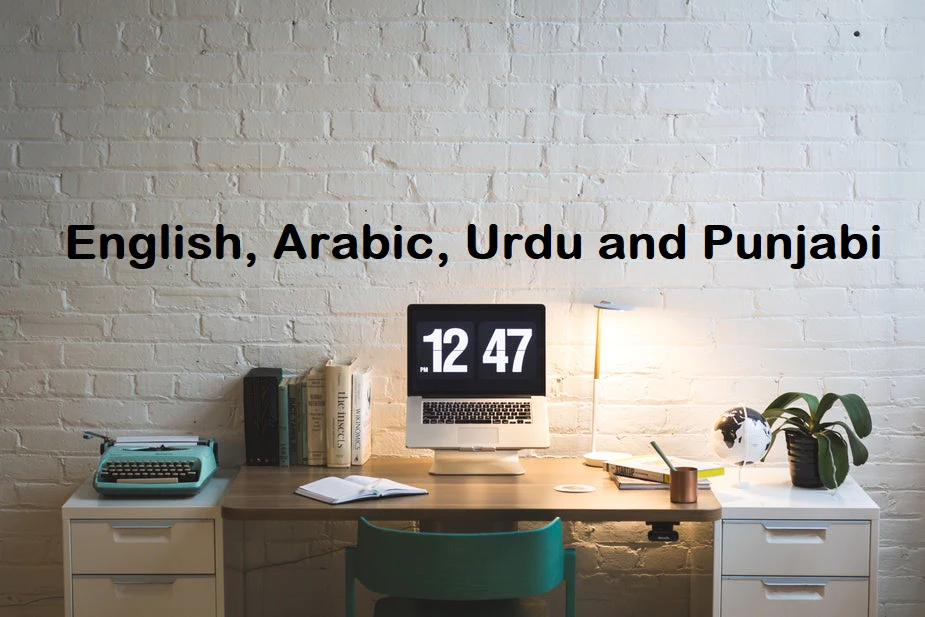Resemblance between Languages
Overview and Comparison ; curious about the differences and similarities between English, Arabic, Urdu, and Punjabi?
Dive into our Curious comprehensive overview and comparison of these four fascinating languages. This blog is suitable for who are interested in languages, whether for academic purposes, career advancement, travel, or personal enrichment.
Overview and Comparison of a language
Language is a powerful tool that shapes our thoughts, culture, and communication. English, Arabic, Urdu, and Punjabi are four languages with rich histories and significant cultural impact. In this blog, we’ll provide an overview of each language, explore their unique features, and compare them to understand their similarities and differences. This guide is ideal for language enthusiasts, students, and anyone interested in linguistic diversity. I try my best to overview and comparison between the language. hope you will learn and enjoy my this little effort regarding overview and comparison of languages
English
Overview
- Origin
English is a West Germanic language that originated in England.
- Global Influence
It is the most widely spoken language globally and serves as a primary or secondary language in many countries.
- Alphabet
Uses the Latin alphabet with 26 letters.
- Dialects
Includes various dialects like American English, British English, Australian English, etc.
⇔Unique Features⇔
- Simplicity
Compared to other languages, English has relatively simple grammar with no gender for nouns and minimal inflection.
- Vocabulary
English has a vast and diverse vocabulary, heavily influenced by Latin, French, and other languages.
Arabic
Overview
- Origin
Arabic is a Semitic language originating from the Arabian Peninsula.
- Global Influence
Spoken by over 300 million people across the Middle East and North Africa.
- Alphabet
Uses the Arabic script with 28 letters.
- Dialects
Numerous dialects exist, such as Egyptian Arabic, Levantine Arabic, and Gulf Arabic.
⇔Unique Features⇔
- Script
This language script is written from right to left, and letters change form depending on their position in a word.
- Tonal Quality
Arabic is known for its rich phonetic quality, with sounds not found in many other languages.
- Grammar
Complex with a rich system of root words and patterns.
Urdu
Overview
- Origin
Urdu is an Indo-Aryan language developed in South Asia.
- Global Influence
It is the national language of Pakistan and widely spoken in India.
- Alphabet
Uses a modified form of the Persian script, which is derived from Arabic.
- Dialects
Includes regional dialects such as Dakhni and Rekhta.
⇔Unique Features⇔
- Script
The script is written from right to left and is highly stylized with complex calligraphy.
- Vocabulary
Urdu has a rich vocabulary influenced by Persian, Arabic, and Turkish, making it highly poetic.
- Politeness
Known for its formality and politeness, with specific words and phrases used to show respect.
Punjabi
Overview
- Origin
Punjabi is an Indo-Aryan language spoken in the Punjab region of India and Pakistan.
- Global Influence
Spoken by over 125 million people, it is one of the world’s most spoken languages.
- Alphabet
Uses two scripts: Gurmukhi (in India) and Shahmukhi (in Pakistan).
- Dialects
Includes Majhi, Doabi, Malwai, and Pothohari dialects.
⇔Unique Features⇔
- Tonality
Punjabi is a tonal language, which means pitch and intonation can change the meaning of words.
- Script Diversity
The use of different scripts in India and Pakistan reflects the region’s cultural and religious diversity.
- Cultural Richness
Punjabi is rich in folklore, music, and poetry, reflecting the vibrant culture of the Punjab region.
|
Comparison |
|
| Phonetics and Pronunciation | |
| English
|
Non-tonal, with diverse vowel and consonant sounds. |
| Arabic
|
Rich phonetic quality with unique sounds. |
| Urdu
|
Soft and poetic with Persian and Arabic influences. |
| Punjabi
|
Tonal language with varied intonations. |
| Comparison | |
| Grammar and Structure | |
| English
|
Simple grammar, no noun genders, minimal inflections. |
| Arabic
|
Complex grammar with extensive root systems. |
| Urdu
|
Formal and polite with intricate script. |
| Punjabi
|
Tonal grammar, with noun genders and verb conjugations. |
| Comparison | |
| Script and Writing System | |
| English
|
Latin alphabet, left-to-right writing. |
| Arabic
|
Arabic script, right-to-left writing. |
| Urdu
|
Modified Persian script, right-to-left writing. |
| Punjabi
|
Gurmukhi (left-to-right) and Shahmukhi (right-to-left). |
| Comparison | |
| Cultural Impact | |
| English
|
Dominant in global communication, business, and media. |
| Arabic
|
Central to Islamic culture and literature. |
| Urdu
|
Rich in poetry and formal discourse, significant in South Asian culture. |
| Punjabi
|
Vibrant in music, dance, and folklore, important in Sikh and Punjabi culture. |
Conclusion: Overview and Comparison Linguistic Diversity
In conclusion, English, Arabic, Urdu, and Punjabi each offer unique linguistic features and cultural richness. Whether it’s the global influence of English, the phonetic beauty of Arabic, the poetic nature of Urdu, or the vibrant culture of Punjabi, each language presents its own set of challenges and rewards for learners. Understanding these languages helps us appreciate the diversity and complexity of human communication.
FAQs
Q: Which language is the hardest to learn among these?
A: It depends on the learner’s native language and personal learning style. Generally, Arabic is considered the most challenging due to its script and grammar.
Q: Can learning one of these languages help with learning another?
A: Yes, learning Urdu can help with learning Arabic due to shared vocabulary and script. Similarly, learning Punjabi can be easier if you know Urdu due to similar grammatical structures.
Q: What is the cultural significance of these languages?
A: Each language is deeply rooted in its respective culture. English is global, Arabic is central to Islamic culture, Urdu is rich in South Asian poetry, and Punjabi is vibrant in music and folklore.










